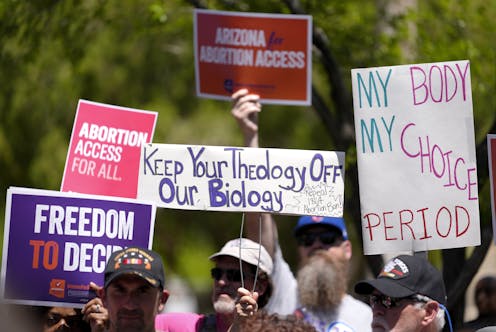Arizona’s now-repealed abortion ban serves as a cautionary tale for reproductive health care across
The implications of restrictive laws or near-total bans go well beyond abortions, reducing overall access to prenatal care, birthing services, routine reproductive health care and more.

When the Arizona Supreme Court ruled on April 9, 2024, that the state’s Civil War-era law banning nearly all abortions was enforceable, it brought into stark reality the potential impacts of leaving reproductive rights up to the states to regulate, and the related consequences for women’s health.
The ruling, set to go into effect in late June 2024, will only remain active for a few months because Arizona lawmakers repealed the law on April 30. Starting in the fall, a previous state law banning abortion after 15 weeks will be reinstated.
The rapidly changing legal landscape and conflicting information has fueled fear and confusion for women, families, hospitals, physicians and other health care providers, and had a chilling effect on abortion services.
We are a health policy expert who studies how laws and policies affect health outcomes, especially for women and children, and a soon-to-be health care lawyer who is focused on health law and policy.
After having studied how reproductive health care has been affected by the 2022 Dobbs decision that overturned Roe v. Wade, it’s clear to us that the implications of bans like those in Arizona and dozens of other states go well beyond abortions. They include reduced availability of safe birthing services, pre- and postnatal care, pap smears, testing for sexually transmitted diseases, family planning, gynecological conditions and miscarriage management.
These downstream effects are not just predicted: They are already playing out in real time in states with the most restrictive reproductive rights laws across the nation.
Hobbling the medical workforce
Policies restricting abortion affect much more than access to abortion.
For one, these laws limit the supply of women’s health specialists like obstetricians and gynecologists, or OB-GYNs. Medical students are less inclined to enter the specialty and more likely to avoid training positions, employment or both in states with restrictive or near-total bans. These states also have difficulty retaining existing OB-GYNs.
This impact on the availability and locations of future women’s health specialists further exacerbates physician shortages, financial strains on families and racial and ethnic health disparities. The dampening effect on the workforce can also worsen the already dismal maternal mortality rates in rural and low-income communities of color.
Having a well-trained and adequate number of OB-GYNs is critical to promoting women’s health. One survey of third- and fourth-year medical students found that 60% were unlikely to apply for residencies in states where abortion is illegal or heavily restricted.
The Association of American Medical Colleges found that there was a 5.2% decline in the number of fourth-year medical student applications for OB-GYN residencies in the 2022–2023 application cycle. This is a steeper decline than in 2021, the year before the Dobbs decision overturned Roe v. Wade.
Most alarmingly, applications to OB-GYN residencies in the 13 states with the most restrictive abortion laws dropped 11% between 2022–2023, signaling a future disparity in the supply of women’s health providers in those states.
Dobbs also affected the retention of OB-GYN residents in abortion-restrictive states: 17.6%, or more than 1 in 6, respondents said they are likely to reconsider where they will practice following their training. They also noted concerns about the potential lack of comprehensive OB-GYN training opportunities in these restrictive states for procedures related to miscarriages, ectopic pregnancies and more.
Reduced access to women’s health care
The Dobbs decision has exacerbated the challenges that women of color and women in rural communities face in accessing women’s health care. Black women account for nearly half of all abortions in the United States yet are more likely to live in a contraceptive desert – meaning areas where they lack access to a full spectrum of contraceptive options – and are less likely to be able to afford the cost of an abortion and associated travel expenses.
A national survey of OB-GYNs found that 70% report racial and ethnic inequities have worsened since Dobbs.
Even before Dobbs, many rural women had to travel more than 180 miles to get an abortion. As a result of state laws banning abortions, at least 66 clinics across 15 states ceased offering abortion services within the first 100 days after the Dobbs decision, leaving many women without access to critical reproductive health care.
As of December 2023, over a dozen states lack an abortion clinic. As more states continue to restrict abortion, these disparities will likely worsen.
Lesser-known downstream effects
As of April 2024, in five states, including Arizona, women cannot get a divorce if they are pregnant. This reality, paired with a lack of access to abortion services, can be deadly to pregnant women, who often experience increased rates of intimate partner violence. One study found that in states where abortion is restricted, homicides rates of pregnant women were 75% higher than in states where abortion is legal.
Nationally, maternal mortality rates have been increasing year after year, even before Dobbs. The U.S. has among the worst maternal mortality rates in the developed world and more than 10 times the rates of some developed nations such as Australia, Japan and Spain.
Stark disparities also exist within American maternal mortality rates: Black and Native women are disproportionately impacted compared to their white counterparts. In 2018, the maternal mortality rate in the U.S. was 17.4 deaths per 100,000 births; in 2021, the rate was 32.9 deaths per 100,000 births.
In 2018–2019, there were 26 deaths per 100,000 births in Arizona, a 43% increase from 2016–2017.
During this time frame, 89.9% of deaths were preventable. A pregnancy-related death is deemed preventable if a maternal mortality review committee determines that the death could have been averted through a reasonable change to the patient’s care.
While extensive post-Dobbs maternal mortality data is not yet available, 64% of surveyed OB-GYNs report that maternal mortality has increased since the decision.
For Black and Native American women, the risk of maternal mortality is even higher. Nationally, in 2021, there were 69.9 deaths of Black mothers per 100,000 births, 2.6 times higher than for white women. Experts anticipate that the Dobbs decision and state restrictions will worsen this racial divide. The maternal mortality rate for Native American mothers has increased drastically in a 20-year period, from 14 to 49.2 deaths per 100,000 births. This trend is highly significant for a state like Arizona with its large Native population.
Health care access helps reduce maternal mortality
Limited access to maternal health care is a critical contributor to maternal mortality rates. Across the United States, approximately 12% of all births occur in counties with little to no access to maternal care, known as “maternity care deserts.”
Women living in abortion-restrictive states are 62.2% more likely to have had no or late prenatal care compared to women living in states where abortion is not restricted. In Arizona, 6.7% of all births occur in counties that lack a hospital with an obstetric unit or obstetric providers.
Women who are forced to prolong their high-risk pregnancies due to abortion bans are at elevated risk of needing emergency maternity care. Without proper maternity care, many of these women will suffer severe complications, and in some cases, they will die.
In the early 1900s, famed women’s rights activist Margaret Sanger stated, “No woman can call herself free who does not own and control her body.”
These words continue to be tested via the political and legal battles taking place.
The authors do not work for, consult, own shares in or receive funding from any company or organization that would benefit from this article, and have disclosed no relevant affiliations beyond their academic appointment.
Read These Next
From record warming to rusting rivers, 2025 Arctic Report Card shows a region transforming faster th
The 20th anniversary of the annual report tracks how sea ice, snow cover and many other vital signs…
2 superpowers, 1 playbook: Why Chinese and US bureaucrats think and act alike
The men and women tasked with implementing policy are governed by the same incentives and constraints…
My prescription costs what?! Pharmacists offer tips that could reduce your out-of-pocket drug costs
High prescription drug costs are leaving many patients frustrated and unable to afford their medications.






